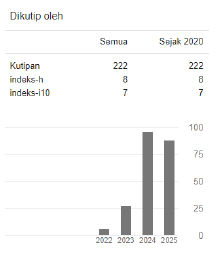Implications of the Communication Technology Revolution in Education and Society of Indonesia
 https://doi.org/10.54012/ijcer.v3i2.328
https://doi.org/10.54012/ijcer.v3i2.328
 Abstract views: 311
Abstract views: 311
 PDF downloads: 176
PDF downloads: 176
Keywords:
Revolution, Communication Technology, Education, Society, IndonesiaAbstract
The communication revolution is growing in the assumption that communication is a vital element in human life. The problem that emerges in the use of communication technology is the perception of the Indonesian people that the social, educational, and economic spheres of technology are regarded as tools that can solve the problems of this world of life easily without paying attention to the effects of these three areas. Industry implications in the field of communications technology are significant for social life, economic growth, and educational dynamics in Indonesia, but also have a threat of negative impacts that are difficult to avoid. The industrialization of the media is increasingly demonstrating how much society and all aspects connected with it, including social, economic, and educational aspects, are in need of information through mass media technology that is growing so rapidly in the age of globalization.
Downloads
References
C. L. Coyle and H. Vaughn, “Social Networking: Communication Revolution or Evolution?,” Bell Labs Tech. J., vol. 13, no. 2, pp. 3–18, 2008, doi: 10.1002/bltj.
J. P. Gee and M. Handford, The Routledge Handbook of Discourse Analysis. 2012.
T. Sugino, E. Abe, and M. Ueda, “Coping With Teacher Demotivation Toward Directed Motivational Currents,” J. Lit. Art Stud., vol. 7, no. 5, 2017.
W. S. Lafitri, A. Suryatmoko, and V. T. Suharto, “Improving Student Recent Writing Skills Using the Project Based Learning (PJBL) Model For Class XI MIPA 3 SMA Negeri 6 Madiun,” Int. J. Corner Educ. Res., vol. 1, no. 3, pp. 138–143, 2023, doi: 10.54012/ijcer.v1i3.167.
A. Briggs and P. Burke, A Social History of the Media: From Gutenberg to the Internet, 4th ed. Cambridge: Wiley, 2020.
M. Herman, C. Mulya, and S. Apriyanto, “The Implementation of Education Financing Through Bos Fund Management in Improving,” J. Inspiratif Pendidik., vol. X, no. 1, pp. 90–101, 2021.
I. Ayu, H. Erlina, D. Santoso, and S. Apriyanto, “Perspective of Parents of Online Learning in Pandemic Covid-19,” J. Res. Business, Econ. Educ., vol. 2, no. 6, pp. 1346–1350, 2020.
S. Apriyanto and A. Anum, “Gender Dynamics on Speaking Interaction in the College Classroom,” J. Smart, vol. 4, no. 2, p. 73, 2018, doi: 10.26638/js.692.203x.
J. K. Burgoon, J. A. Bonito, B. Bengtsson, C. Cederberg, M. Lundeberg, and L. Allspach, “Interactivity in human-computer interaction: A study of credibility, understanding, and influence,” Comput. Human Behav., vol. 16, no. 6, pp. 553–574, 2000, doi: 10.1016/S0747-5632(00)00029-7.
Z. Nasution, “Konsekuensi Sosial Media Teknologi Komunikasi Bagi Masyarakat,” Reformasi, vol. 1, no. 1, 2011, doi: 10.33366/rfr.v1i1.9.
A. Giddens, The Third Way and its Critics. Cambridge: Wiley, 2013.
A. F. Sari, “Etika Komunikasi,” TANJAK J. Educ. Teach., vol. 1, no. 2, pp. 127–135, 2020, doi: 10.35961/tanjak.v1i2.152.
M. McLuhan and W. T. Gordon, Understanding Media: The Extensions of Man. California: Gingko Press, 2003.
Y. A. Tangkasiang, “STUDI PENERAPAN TEKNOLOGI TEPAT GUNA TERHADAP PERUBAHAN SOSIAL NELAYAN KARAMBA DI KELURAHAN PEMBUANG HULU I, KECAMATAN HANAU, KABUPATEN SERUYAN, PROVINSI KALIMANTAN TENGAH,” J. Sociopolitico Fak. Ilmu Sos. dan Ilmu Polit., vol. 4, pp. 71–79, 2022.
J. D. Straubhaar and R. LaRose, Media Now: Communications Media in the Information Age. Ohio: Wadsworth, 2000.
M. D. Anggraeni, R. Mucharromah, B. Z. Taqiyya, R. E. Fadilah, I. K. Mahardika, and F. Yusmar, “PERKEMBANGAN TEKNOLOGI DAN KOMUNIKASI DALAM PENDIDIKAN,” FKIP e-PROCEEDING; 2022 Semin. Nas. N-ConferSE III 2022, Jan. 2023.
M. S. Al Auny and A. Arrohmatan, “MANAJEMEN PENDIDIKAN HUBUNGAN MASYARAKAT BERBASIS HUMANIS MULTIKULTURALIS ABDURRAHMAN WAHID,” J. Insa. Cendekia, vol. 4, no. 1, pp. 11–24, 2023.
S. S. Hasnida, R. Adrian, and N. A. Siagian, “Transformasi Pendidikan di Era Digital,” J. Bintang Pendidik. Indones., vol. 2, no. 1, pp. 110–116, 2024.
S. Handayani, N. Alfira, L. N. Rokhman, and E. Inayah, “Komunikasi Pembangunan di Indonesia: Telaah Pemikiran M. Alwi Dahlan & Santoso S. Hamijoyo,” Imagining e-Indonesia Local Wisdom Midst Media Technol. Commun. Policy, vol. 53, no. 9, pp. 1689–1699, 2015.
L. Harahap, “PERAN TEKNOLOGI INFORMASI DAN KOMUNIKASI DALAM PENDIDIKAN,” in Prosiding Seminar Nasional Teknologi Pendidikan Pascasarjana UNIMED, 2019, pp. 375–381.
N. Masruroh, “Media Sosial Dalam Lanskap Masyarakat Industri Dan Kaitannya Dengan Budaya Populer,” Publiciana, vol. 15, no. 1, pp. 28–37, 2022.
Downloads
Published
How to Cite
Issue
Section
License
Copyright (c) 2024 Achmad Asrori, Nasor, Dani Amran Hakim, Nina Ayu Puspitasari, Heni Anggraini, Adelina Anum

This work is licensed under a Creative Commons Attribution-ShareAlike 4.0 International License.









